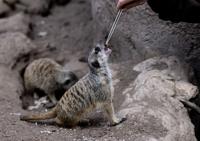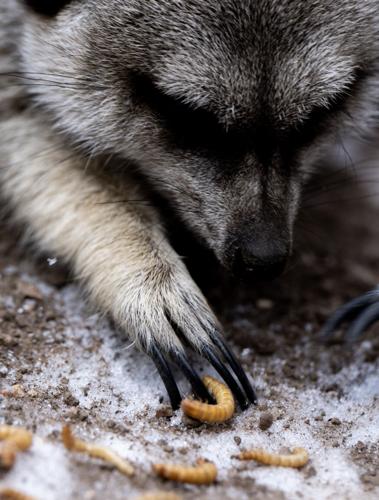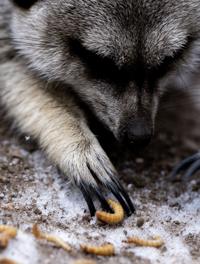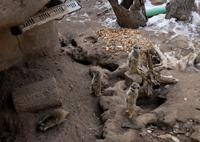Meet the meerkats at Cheyenne Mountain Zoo.
It doesn’t take much to make a mob of meerkats happy.
Give the little scamps some cockroaches, a mound of dirt, a heat lamp and call it good.
That’s the order of a frigid January day that finds brothers Havoc, Pandemonium and Nugget and their paterfamilias, Kamikaze, scampering around their Cheyenne Mountain Zoo exhibit.
After senior keeper Brooke Powell carefully enters the bachelor pad, the tiny characters dart here and there, before approaching their caretaker. They know what treats she might hold — bugs, bugs and more bugs.
On today’s dietary agenda? Mealworms and cockroaches. And from the shape of bellies, it’s easy to see who procures the most insects: “Havoc’s the more dominant one of the group. That’s why he’s the big boy,” Powell said about the 4-year-old.

A meerkat snags a bug from senior keeper Brooke Powell.
But 4-year-old Pandemonium isn’t afraid to tangle with his brother for snacks, even though he’s the smallest of the foursome: “He’s the sweetest and friendliest, and in my mind, the most innocent,” Powell said.
Toward the back of the exhibit is 6-year-old Nugget, the most energetic meerkat and easily distinguished by his uber short tail that came about due to an injury when he was younger.
And the much less gregarious Kamikaze also lurks in the back, by the homemade tunnels they’ve dug and by his favorite creation — the heat lamp. The 14-year-old has a mug on him just like an older dad, who’s long managed to ignore his sons’ shenanigans. Apparently, his lack of stress is working out health-wise, as a meerkat’s median life expectancy is 10.
“He acts just like an older dad — not (a) care in the world when his kids are running around and play fighting and wrestling,” Powell said. “Sometimes when he’s lounging, he creates a little divot in the dirt, lays back and looks like a dad on Sunday watching football.”
Let the sunshine in
This mob loves the glow from their outdoor heat lamp, which makes sense as they hail from the deserts of South Africa. Round the corner of their exhibit and you might see four boys standing up on their back legs, arms straight down in front of their fuzzy bellies, faces pointed upward toward the heat lamp attached to a rock. They might turn their head to investigate you for a moment, but then it’s straight back to the warm rays. Keepers often arrive in the morning, and before they can turn the lamp on, they’ll find the little guys relishing the sunshine. And don’t worry, they always have access to an inside den, plus all their tunnels, so they do fine in low temperatures.

The bachelor mob of meerkats bask in the warmth of their heat lamp. (Parker Seibold, The Gazette)
Dig this
Any tunnels or holes you see in their exhibit are handmade by the busy boys. Meerkats can dig their entire body weight, which is around 2 to 2½ pounds, in seconds. Keepers do make sure the tunnels are well-supported and secure. And other times, for enrichment purposes, they’ll collapse the tunnels so the meerkats have to start from scratch. It helps keep them busy.
“They build their own house. It’s very intricate. Some days I fall into a hole and I’m down to here in dirt because it goes pretty deep,” Powell said.

With the face of an old man, Kamikaze, the paterfamilias of the bachelor mob, is easy to pick out of the group. (Parker Seibold, The Gazette)
A working mob
Meerkats take up different jobs in their mob. For instance, Nugget is typically on sentry duty. He keeps a lookout for potential threats, then warns his crew through different vocalizations whether the threat is in the air or on the ground.
And if there’s a breeding pair and babies, the whole mob will pitch in to take care of them. One will take up babysitting duties, other females will become wet nurses and help feed the babies, and others will teach them how to hunt.
Are they really barking?
Yes, just like the tiniest of dogs. After a keeper dumps out a bucket of crunchy leaves in the exhibit, Kamikaze scurries over and starts digging, pausing to look around and utter a series of short yaps. It’s not necessarily a bark of either happiness or displeasure: “It’s mostly like he’s aware we’re here,” Powell said. “If it wasn’t a happy one you’d be able to tell. Usually it’s not toward us. It’s when they’re playing and wrestling.”
More mobs than you can shake an earthworm at
Two more mobs live at the zoo, but in different locations. Sisters Thumper and Chase are related to the bachelor brothers. And Hullabaloo and Sage, a recommended breeding pair who were introduced in April. Meerkats tend to reproduce in the warmer months, so keepers have high hopes for spring and summer now that the pair are better acquainted and getting along well. Meerkats can reproduce quickly — gestation is 11 weeks, and they can get pregnant immediately afterward.
Contact the writer: 636-0270














 Your Privacy Choices
Your Privacy Choices